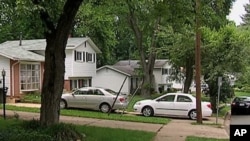The U.S. population has passed the 300-million mark in the past decade, with non-white groups accounting for most of that growth. A new study of census data for 100 major metropolitan areas in the U.S. shows that many black, Asian, Hispanic, foreign-born and single people are moving to the suburbs, once populated mostly by white middle-class families with children.
Annandale High School has more than 2500 students, from 85 countries. They speak more than 40 languages. The number of students has grown so much in the past decade that many classes take place in a trailer park behind the main building.
The school has five full-time employees to help new immigrants. They're fluent in Vietnamese, Spanish and Korean. Honduran-born Dinora Gonzalez is a liaison for Hispanic families.
"I deal mostly with low-income families and they don't speak English so they call me for any issue in the school and I get in touch with the school staff, like counselors, teachers and vice versa," said Gonzalez
Annandale High opened its doors in 1954 to a few hundred white students. Almost all of the residents in the vicinity were white middle-class families with children.
Catherine Quigley's family moved into the neighborhood in 1962. All of her three children attended Annandale High.
"When my son graduated in 1977 there were about 680 students. Of that 680, one person was African-American," noted Quigley.
Quigley is one of many original residents who have stayed in the neighborhood as they've aged. She says most of her neighbors now are Asians, Hispanics and Middle Easterners. Many of them do not speak English. And she says some of the community spirit has been lost.
"It was a real neighborhood when we moved here, even though people were from all over the country," she said. "They had come from cities or villages or towns where it was just expected that you were part of a community. Now it's not."
But she has made friends with a Lebanese family who moved across the road six years ago.
Joseph Moura moved out of Lebanon ten years ago, after his brother, a policeman, was killed in political violence. He says Annandale has everything his family needs.
"First, my wife does not drive here. She does not have a driver's license. Here the shopping is close. Everything is - gas, laundry - everything is close-by here. So she can even walk," Moura said.
Moura was a well-paid chef in Lebanon, but he had to change his profession to be able to support his family in America. Today he runs a small construction business. Like Moura, immigrants have to adjust to a new life, but they also have a profound impact on the United States. William Frey is a demographer at Washington's Brookings Institution.
"People from other parts of the world - Latin America and Asia - are bringing different languages, different cultures and different ways of doing things to this country," noted Frey.
Frey says immigrants, who used to settle in major entry ports, such as New York, Miami and Los Angeles, are now moving into many other metropolitan areas. And suburbs, especially those with good schools, attract families with young children. Frey says governments, schools, employers, and politicians running for office will have to connect with these new immigrants. Many Americans are already doing that.







